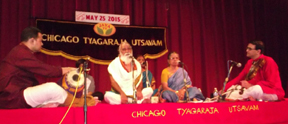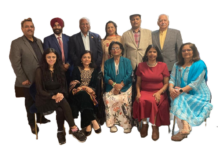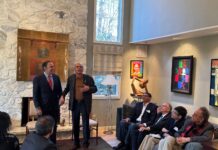
CHICAGO: “Unrevealed Compositions of Oothukadu Venkata Kavi” were presented by Needamangalam Subbaraman, Ph.D., and Needamangalam Selvi Alamelu, leading Harikatha performers from India at the Thyagaraja Festival (TF) here at the Hindu Temple of Greater Chicago on May 25. They were accompanied on violin by Jayashankar Balan and on mridangam by Vinod Seetharaman.
Following invocatory prayers, Subbaraman and Alamelu sang “Ananda-narthana -ganapathim bhaavaye” in the energetic ragam Nata, a very popular and joyful dance composition. “Aalavadennalo shivame” in Pharaz served to illustrate Kavi’s habitual and delightful resort to swaraakshara, that is, where the utterance of the musical note (swara) coincides with the syllable (akshara) of the lyrics being sung. Here the notes “pa” and ‘dha’ express the lotus feet (pada) of the Lord.
Subbaraman explained that Venkata Subba Iyer (c.1700 to 1765 CE), popularly known as Venkata Kavi lived before Thyagaraja’s time in the village of Oothukadu near Tanjore in Tamil Nadu.
He was a master composer and great devotee of Lord Krishna. With their attention to rhythm, his compositions (kriti) numbering over 400 in Sanskrit, Tamil and Marathi stand out in lyrical and aesthetic beauty. Most of his kritis invoke episodes from the epics, Bhagavatam and Ramayanam. Many are ideally suited for dance, as their rhythmic phrases and patterns lend themselves to footwork. They also include descriptions of goddess Kamakshi and operas such as the stories of Prahlada and Dhruva.
Harikatha is a traditional art of story-telling judiciously interspersed with song. Maestro Subbaraman narrated the poet’s life and his enthralling Puranic dialogues: between monkey-god Hanuman and warrior Bhima of the Mahabharata and, in another instance, when preceptor Vishwamitra takes Rama and Lakshmana to the forest to protect the sacrifices (yajna) conducted by the sages. Kavi’s compositions reveal different themes, devotional, folk, moral, philosophical and mythological.
The presenters concluded with a superb rendition of the famous thillana (briskly rendered pure dance), in ragam Nata, “Kalinga Nartana” that describes five-year old Krishna dancing on the seven fiery hoods of the once-mighty now-vanquished serpent Kalinga, which was poisoning the holy river Yamuna with his fumes, along with their dialogue.
Its various rhythmic phrases (gati), such as, ta-dhi-gi-na-tom, allow dancers to depict the brisk movements in a dramatic and effective manner. This “Kalinga Nartana” was brought to light by Kavi’s descendant Needamangalam Krishnamurthi Bhagavathar.
Highly appreciative of Subbaraman and Alamelu for propagating and popularizing Kavi’s compositions, TF founder Dr Raghavan encouraged dancers to collaborate with them in producing great musical operas.
Dr Jaishree Prasad






